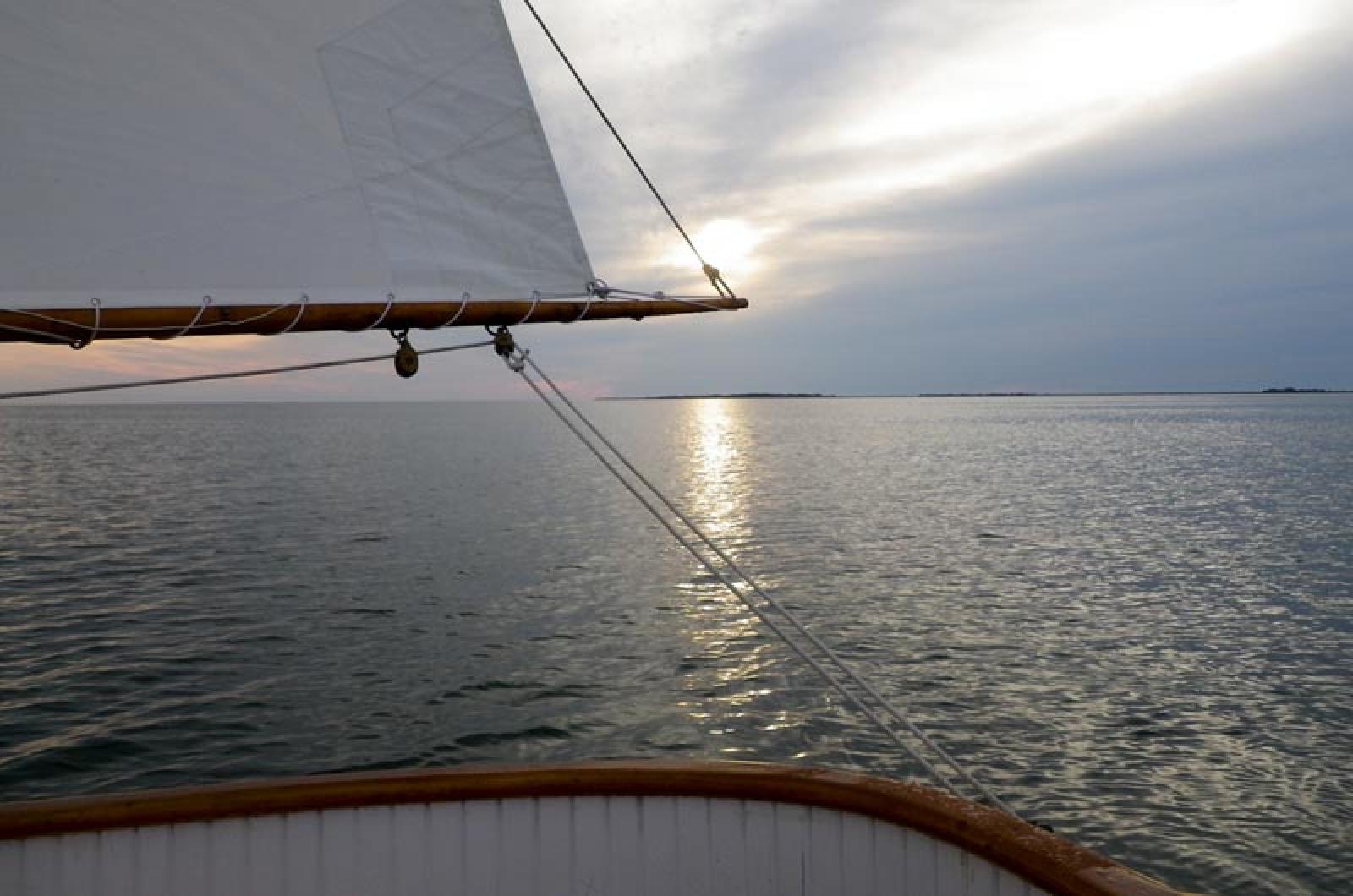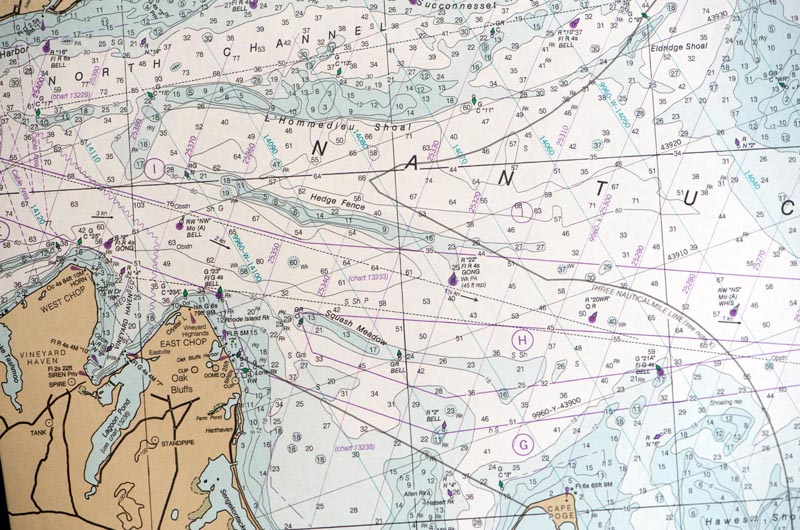For many fishermen, boaters and sailors, Nantucket Sound is a neighborhood. It is an inland sea with personality where stories abound. The sound ranges in size from 500 to 700 square miles, depending on who is doing the measuring. Nantucket Sound is the water that separates Cape Cod from Nantucket and much of the Vineyard.
Call it an inland sea, marked by lighthouses and aids to navigation that surround it like the jewels on a necklace. It starts with Great Point on Nantucket and it ends with Nobska Light to the west. The list of lighthouses a sailor can see from a vessel traversing the Sound is even more extensive and begins with Gay Head light to the west, Tarpaulin Cove, West Chop, East Chop, Edgartown Light and Cape Pogue Light. Add to that Sankaty Light on Nantucket, the farthest to the east. There are other lights including Bishop and Clerks, Point Gammon and probably many more.
Were someone to magically remove all the seawater from Nantucket Sound, the landscape would be astounding. The bottom of Nantucket Sound has the personality of the rolling hills of West Tisbury, but instead it is made of shifting sand and large boulders.
The bottom of Nantucket Sound has a profile of a countryside landscape, but it is the currents of the moving seawater that has carved its profile. Twice a day the current within the Sound may seem to stop, but twice a day the waters can also speed up to as fast as four knots.
There is nothing stationary about the surface. The seas in the sound can kick up within a few hours to that of the ocean, particularly in a Northeaster. Storms have left their imprint not just on the shore.
In the days before sonar, radar and electronic navigational tools, there were lightships in Nantucket Sound, to mark the treacherous shallow waters. They were the Hedge Fence Lightship, Succonnesset Lightship, Cross Rip Lighthouse, Handkerchief Lightship, and others.
Despite the aggressive efforts by lightships and lighthouses and buoys to keep ships safe, storms, fog and human error took their toll. The bottom of Nantucket Sound is full of evidence of man’s folly. Broken ships mark the sandbars. In some cases the wood of a ship may have rotted away, the iron of a ship rusted away, and the evidence left is the cargo.
At the site where the schooner John Paul sank at the turn of the century, there is a hill of huge blocks of granite. Each block is six feet in size, piled high, and undeterred by the movement of the sand.
There is coal left over from some lost coal-carrying vessel down amidst the sandy bottom in the waters off Joseph Sylvia State Beach.
Hedge Fence off Oak Bluffs is the permanent home for a World War I era 380-foot ship called the Port Hunter. There are many other ships and the charter fishermen know most of them, as the fishing is good if you drift a baited hook above or near one. Lost ships are artificial reefs and they provide shelter for bait fish and the bigger fish that pursue them.
The sandy bottom of Nantucket Sound is also the home of large boulders, delivered by the receding glaciers of thousands of years ago. Many of these boulders have names, some do not. Rhode Island Rock is off Vineyard Highlands in Oak Bluffs. Mill Rock is outside of Edgartown Harbor. Whether named or not, most of these rocks are adorned with lost fishing line, fishing lures, gear and maybe even an anchor or two.
Sandbars have names too, more names than the hills of the Vineyard. Sailors like sandbars and shoals with names. For a sandbar without a name is nearly always troublesome. L’Hommedieu, Squash Meadow, Hedge Fence and Horseshoe Shoals all come pretty close to the surface.
Groundings on a shoal isn’t an old phenomena. As recently as July of last year, an 84-foot sea scallop fishing boat, Kris and Amy, grounded two miles east of Oak Bluffs. It took a high tide and a tugboat to free her from the sand of Hedge Fence.
To the east of the Vineyard and on the way to Nantucket there are many treacherous shoals: Tom, Hawes, Mutton and Tuckernuck Shoals. Add up all of these underwater shallow areas and they occupy an area almost as big as Nantucket. Nantucket Sound has plenty of shallow water. Anglers know them as fishing spots. Sailors with deep draft boats, know them as places to stay away from.
The bottom landscape of Nantucket Sound can vary from less than five feet to 85 feet deep. The Sound is home for black sea bass, scup, bluefish, striped bass, false albacore, bonito, cod, tautaug, and it is a summer refuge for fluke. Itis the breeding place for black sea bass and squid and conch.
At night Nantucket Sound is a large black sea surrounded by a ribbon of lights. Nobska Lighthouse sends out a white flashing beacon, as does West Chop light. But for those who navigate Nantucket Sound, these two lighthouses share another color, a red to mark worrisome areas. The Nobska Lighthouse beacon is red when the light is pointing over L’Hommedieu and Hedge Fence.
West Chop lighthouse shines white, except for those traversing a narrow area between just off East Chop and Eastville.
Great Point lighthouse on Nantucket also has a red sector, though it is principally a white beacon. The red beacon marks the shallow areas between Nantucket and the Vineyard. For sailors traveling north of that area, the Great Point Lighthouse shines white.
The East Chop lighthouse beacon is a slow flashing green, a rare color among all the lighthouses. The Edgartown Lighthouse shines red. Cape Pogue lighthouse is a flashing white.
Harvey Russell, an Oak Bluffs charterfisherman, runs My Brother Charters and also works on The Skipper, a party fishing boat out of Oak Bluffs. Mr. Russell lives on Seaview Extension, a road that overlooks the Sound.
“It is a fisherman’s paradise. What is so nice about Nantucket Sound is you don’t have to go far. Some have to travel 45 minutes to catch the same fish we catch here.” Mr. Russell has watched many sunrises over the Sound. “They are all different,” he said.
Arnold Carr, 71 of Monument Beach, grew up in Oak Bluffs. Though he retired from the state Division of Marine Fisheries after many years of fisheries work, he continues to work as a professional diver. Since youth he has dived around the many shipwrecks of Nantucket Sound.
“In the days before GPS, I used to transit to the Island from the mainland over Nantucket Sound. By using a compass and a depth finder, I always knew where I was, once I left Falmouth, by knowing my heading and the water depth.” The variation in water depth would range from 20 to 80 feet. He said he knows all the shoals by memory.
James Tietje, 57, is president of Patriot Party Boats. For decades he has captained the Patriot Too across Nantucket Sound. He works as a captain of commuting boats, and has gone through the worst of storms and calm water. He is also a charter fisherman and has taken his clients to where the fish are biting. Mr. Tietje said that those who work on Nantucket Sound know each other pretty well, certainly by voice on the marine radio. To him, the Sound is a community of boats and voices and the faces of those who run those boats.
There is great joy, Mr. Tietje said, when it comes to greeting his old friends ashore on the dock. “You know, you don’t get to see the faces of the people you hear on the radio. It is so nice when you bump into someone on the dock, a person you know but a face you don’t see. You know them by the boats they are fishing in. You know them in the draggers they fish. But you don’t see them often enough face to face. So it is really great when you get a chance to meet them at the dock and then the stories start coming out,” Mr. Tietje said.
“It is my neighborhood,” added Mr. Russell.








Comments
Comment policy »